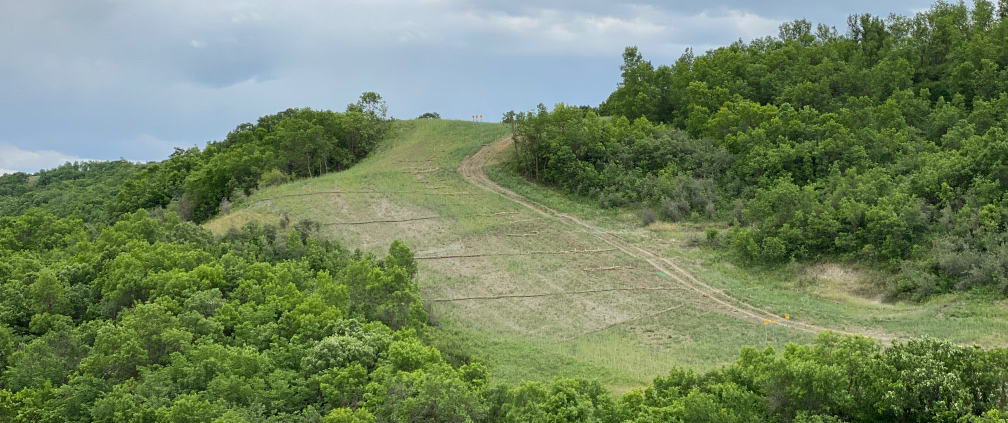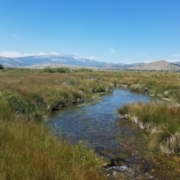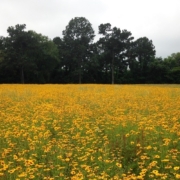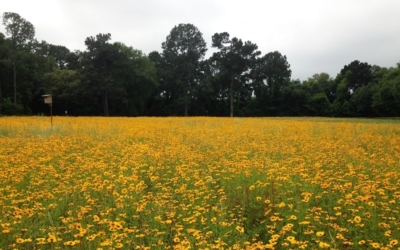Crestwood Midstream | Expediting Reclamation through Innovation, Corporate Support and Community Ties
Reclamation is a complex task, requiring intensive planning that begins before a company even starts work in an area. Restoring land in a narrow timeframe, while meeting the expectations of the surrounding community, is even more challenging, but the team at Crestwood Midstream has readily risen to the occasion.
Crestwood’s grassland reclamation project is located on 16 acres along multiple pipeline rights-of-way (ROWs) in western North Dakota. The ROWs run through the Fort Berthold Indian Reservation (FBIR), inhabited by the Mandan, Hidatsa and Arikara (MHA) Nation, also known as the Three Affiliated Tribes, and the reclamation work included in the project is representative of practices Crestwood has adopted for pipeline construction throughout the reservation. The area features mixed prairie grasslands that wildlife, along with residents’ livestock, use for grazing. Permitting for ROWs through the reservation is handled by the Bureau of Indian Affairs (BIA), who estimates that successful reclamation is typically completed 3-5 years after construction disturbance. The Crestwood team, however, has been determined to shorten this window, often reducing the timeline for successful habitat reclamation to approximately two years.
Matt Comeaux, Crestwood’s Director of Environmental Services, oversees all aspects of pipeline construction: permitting, construction and post-construction compliance, and ultimately reclamation. He cites a multitude of benefits to completing reclamation at a quicker rate, from overall project lifecycle cost and labor reductions, to less risk of erosion, noxious weed infestations and greater biodiversity.
To expedite the process, the team has adopted a suite of best management practices. Before construction, topsoil depth surveys are performed. Noxious weed control is conducted prior to soil grading. During construction, the team actively manages topsoil and subsoil storage to minimize mixing, and uses robust erosion control devices to minimize soil loss and erosion. Once construction is complete, weed-free straw is incorporated into the topsoil for erosion control, water retention and soil nutrition.
Instead of the standard seed mix typically used for reservation reclamation projects, the team worked with consultants to create their own. Matt explains, “We look at coming up with the best seed mixes we can, consulting with experts from the NRCS, to incorporate species better adapted to disturbed soil scenarios.” In selecting plant species, the team takes care to include native forbs to increase the area’s biodiversity, wildflowers for pollinators and plants with cultural significance to the MHA Nation. Stiff goldenrod, for instance, is used in antiseptic lotions and teas and provides forage for carpenter bees and livestock.
Many of the easements granted to the Crestwood team are not exclusive, meaning that grazing activities and travel across reclamation sites are common. While Matt notes that “it’s much more challenging to achieve successful reclamation” with the high activity, the team has found unique ways to attempt to minimize the impact. In one case, a landowner requested that the team build an access road through his property. Matt recalls, “The terrain was challenging, but we were able to incorporate the road into the reclamation design to make it as minimally impactful as possible.” The access road was constructed using local stone that forms at coal seams, and its design limited permanent disturbance within the construction ROW, allowing for better plant establishment on the rest of the property.
Crestwood’s connection with the community was further solidified by the contributions of one of their field employees, Christopher McLaughlin, a Senior Environmental Specialist and member of the MHA Nation. Before joining Crestwood, Christopher worked for the BIA as an Environmental Specialist, making him well versed in what regulators evaluate when siting and permitting oil and gas projects on FBIR. He now oversees much of the pipeline construction and reclamation in the area, capturing spatial data through Geographic Information Systems (GIS) and sending it back to Matt and the rest of the team at Crestwood’s Houston, TX headquarters. Matt notes that Christopher approaches reclamation with a “very high level of pride” and a sense of ownership in the work. The team’s level of investment and attention to data collection provided a streamlined path to WHC Conservation Certification®, and they are already planning for the next certification cycle.
This proactive mindset, and motivation to exceed minimum regulations, can be found at all levels of Crestwood leadership. Crestwood’s CEO seeks to be an ESG leader in the industry and has welcomed Matt and his team into board meetings to present site-level conservation work. Joanne Howard, Vice President of ESG, Sustainability and Corporate Communications, has worked to develop Crestwood’s ESG program from the ground-up. Aided by WHC’s unique expertise in corporate conservation strategies, she made biodiversity and land use a key focus of the company’s ESG approach. Recalling how Crestwood’s corporate culture smoothly facilitated collaboration, WHC Chief Operating Officer Josiane Bonneau says, “We learned so much and were impressed by the team’s commitment to the MHA Nation and the community at large. We left uplifted and excited to see more of their impact in the future.”
Crestwood has ambitious plans for the coming years. Joanne’s team is in the final year of a three-year strategy, and moving forward, they will complete a materiality assessment to develop a new set of goals. At the site level, the team looks forward to expanding on their already-thriving reclamation work. They plan to continue developing seed mix, sowing test plots under different conditions and are constantly working to perfect the timings of plantings, given North Dakota’s short growing season. They also want to evaluate potential Certification opportunities on their assets located in eastern Wyoming.
Matt’s advice to other teams with reclamation projects is to approach them with a sense of openness. “Don’t be scared to think outside the box,” he advises. “There are a lot of challenges in the field and you’re continually trying to improve upon your plans.” With dedication at all levels of operation, flexibility and a mindfulness for the unique landscape and community in which they operate, the Crestwood team is well on their way to becoming the industry leaders they aspire to be.
Related Content
- Blogs:
- Webinars:
- Project Guidances:
- White Papers:
Quick Facts
| Site Name: | FBIR Grassland Reclamation |
|---|---|
| Category: | Member Spotlight |
| Tag: | grasslands |
| Site Location: | Fort Berthold Indian Reservation, North Dakota |
| Partners: | Agassiz Seed & Supply, Gemini Resources Group, Natural Resources Conservation Service, Northern Plains Erosion Control, LLC, SWCA Environmental Consultants |
| Project Type: | Grasslands |
| Certification Since: | 2021 |
| WHC Index Link: | Learn more about this program |






